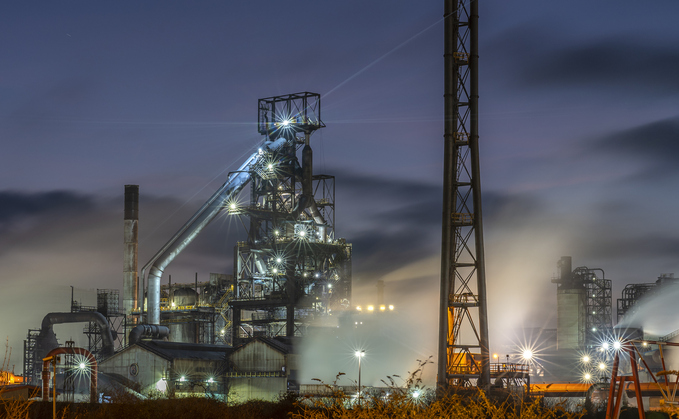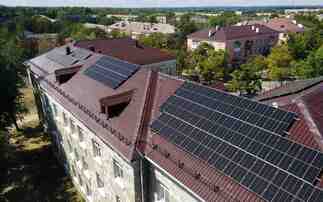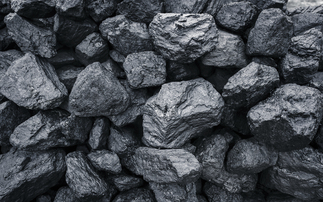
Tata Steel's Port Talbot site, one of two integrated steelworks in the UK | Credit: iStock
The race for green steel is now firmly underway - BusinessGreen looks at the technologies the UK's largest steelworks could tap to get ahead
The decision to reline a blast furnace is an important decision point for a steel company. Typically undertaken every 20 years, the exercise normally costs upwards of a billion dollars, once capital expenditure and revenues lost through halted production is taken into account. And for steelmakers operating in the 21st century, it is also the moment where they decide whether to "lock in" carbon-intensive practices that have been in place for decades or take a leap towards a greener future.
There are four operational blast furnaces in the UK that transform coking coal into primary iron: two at British Steel's operation in Scunthorpe in Lincolnshire, and two at Tata Steel's Port Talbot steelworks in Wales. Decisions made this decade about whether and how to extend the life of these enormous pieces of kit are set to be hugely consequential in the UK's transition net zero.
All four of the UK's blast furnaces need relining by 2035, with two requiring the essential repair before the end of this decade, according to think tank Green Alliance. As such, it has warned that the "feasible economic window" to reduce the carbon intensity of the UK's two integrated steel sites - which together make more than 95 per cent of emissions from the UK's iron ore and steel sector - is shrinking. With steel making up roughly 15 per cent of the UK's industrial emissions, decarbonisation of steel - and the Scunthorpe and Port Talbot sites in particular - is critical if the UK is to meet its climate goals.
But the ‘green' transformation of the steel sector is not just a climate imperative. Experts have pointed out that the competitiveness of the UK's embattled steel sector rests on its ability to keep pace with other countries that are embarking on their own journeys to decarbonise iron ore and steel production.
Because, after years of being classified as a "hard-to-abate" sector, steel decarbonisation is now occurring at pace across Europe. In southern Sweden, the HYBRIT project is already up and running, and has delivered its first batch of ‘fossil free steel' to customers. It is planning to deliver commercial production in 2026. Swedish start-up H2 Green Steel is aiming to open the "world's largest" green steel plant up by 2024.
On the continent, steel giant ArcelorMittal has committed to spending €1.7bn on the decarbonisation of its steelmaking sites in northern France and is aiming to have a zero-carbon steel plant commissioned in Spain by 2025. Its competitor Thyssenkrupp has committed $1.9bn to replace one of its blast furnaces in western Germany.
Clearly it is not solely the UK's carbon goals that depend on whether and how quickly operations in Scunthorpe and Port Talbot are decarbonised, but the future of an industry that employs more than 34,000 people. Demand for so-called ‘green steel' is on the rise, as carmakers and other major steel buyers look to meet their own climate goals.
Carbon prices are ratcheting up around the world, cutting into the profit margins of industries that continue to rely on carbon-intensive processes.
Frank Aaskov, energy and climate change policy manager at UK Steel trade body, stressed that decarbonisation potentially offers a new lease of life for the UK's long-struggling steel sector. "Why not produce steel here in the UK in a low emission way?" he asked. "The more steel we produce the better, because every time we produce a ton of steel in a lower emission way here, we replace a ton of steel being produced in a very carbon-intensive way abroad. There's an incredible opportunity to reindustrialise in the UK in a new and climate-friendly way."
It is an opportunity the industry wants to seize. The owners of the UK's major steelworks have committed to achieve net zero by 2050 and are exploring avenues to get there. British Steel published a low carbon roadmap last year setting out how it plans to reduce its emissions by 78 per cent on 1990 levels by 20235, by tapping a range of technologies.
Tata Steel UK has indicated on a number of occasions that it intends to transition Port Talbot away from blast furnaces, most recently as part of an appeal for an aid package from government that it said would both keep it afloat and spur its decarbonisation.
But as Tata Steel UK's appeals underscore, these plans are being developed at a time when Britain's steel industry is facing huge headwinds. Rising inflation and soaring energy costs in the wake of Russia's invasion of Ukraine have added to the embattled sector's longer-standing challenges. In recent months, both Tata Steel Group and British Steel's Chinese owner Jingye have made appeals for financial support from government to the tune of £1.5bn and £500m, respectively.
Ministers have not indicated how it will respond to these calls, nor to appeals from campaigners for investment to be funnelled into ‘greening' the sector so as to protect tens of thousands of jobs and meet climate goals.
Two technological pathways
So what options are there for Britain's largest steelmakers, both of which are facing decisions about whether to close, extend or convert ageing blast furnaces?
There two broad technological routes available for decarbonising steel. The first is to fit carbon capture and storage (CCS) technology on older plants to prevent their significant emissions from reaching the atmosphere. This approach has been proven at a steel plant in the United Arab Emirates which captures carbon dioxide for enhanced oil recovery.
British Steel, the company behind the Scunthorpe steelworks, has calculated it can slash its emissions by 24 per cent by 2035 by introducing CCS technology at its plant. The site benefits from its location on the Humber industrial corridor, where a network of pipelines is being planned to transport captured carbon dioxide to a depleted reservoir in the North Sea for storage.
The second approach to decarbonising steel is doing away with blast furnaces altogether and scaling and adapting a lesser-used method of steelmaking called direct reduced iron (DRI), which uses a gas to make steel out of virgin iron ore. The so-called "reducing agent" in this process has historically been fossil gas, but it can be swapped for low-carbon hydrogen to produce 'green' steel. The resulting sponge iron, also known as DRI, can then be fed into electric arc furnaces (EAF), alongside scrap metal, where it will be melted into steel using electricity.
EAFs are a well understood technology, already responsible for roughly 25 per cent of global steel production. There are four EAF steelworks that melt scrap steel into new steel using fossil gas and electricity in the UK, and the HYBRIT plant in Sweden, a project backed by mining company LKAB, steelmaker SSAB, energy company Vattenfall, has taken this approach, producing steel using hydrogen and electricity through a DRI-EAF approach.
But experts say that to reach net zero, EAFs share of the market must rise significantly over the coming years, alongside rates of scrap material recycling and production of hydrogen-based direct reduced iron.
Some estimates suggest blast furnace method of production would need to fall from around 70 per cent today to 18 per cent in 2050 to achieve climate goals, helped by investments in DRI units, electric furnaces, hydrogen capacity, and recycling infrastructure. In the UK, Green Alliance has calculated the steel sector could decarbonise its emissions by more than 87 per cent by 2035 by phasing out blast furnaces.
Experts have pointed out the UK, as the first country to industrialise, has a healthy pipeline of scrap steel that it should be repurposing for EAFs. Green Alliance calculates the UK currently discards roughly 9.9 million tonnes of scrap steel a year, of which 8.7 million tonnes is exported. Ramping up the amount of scrap steel could reduce the UK's imports of iron ore by 76 per cent by 2035.
Both British Steel and Tata Steel UK have indicated they plan to transition at least a portion of their business to EAF steelmaking over the coming years. The former's net zero plan calculates the company will be able to achieve a 28 per cent reduction of its emissions by 2035 through by transitioning to EAF steelmaking and other "new ways of working".
The Financial Times reported in July that Port Talbot's managers are aiming to convert to electric arc furnace production, in a pivot away from a previous strategy focused on carbon capture technology in the wake of the South Wales Industrial Cluster's unsuccessful bid for CCS funding.
'Starting a bit behind'
In a government-commissioned strategy for decarbonising the sector, trade body UK Steel placed equal weight to both what it dubbed the "electrification" and "CCS" avenues of steel making, both of which it said could be followed by a "hydrogen-based approach" from 2035 onwards.
Proponents of CCS argue have argued the UK's plans to develop carbon capture pipelines across industrial clusters make it a promising location for a CCS-approach. They have also argued that hydrogen-based steelmaking could be a major challenge in the UK, which has some of the highest electricity prices for industrial plants in Europe. Not only does DRI-EAF approach rely on the build-out of low-carbon hydrogen production capacity that is yet to be planned in the UK, but it depends on vast amounts of electricity.
The HYBRIT project estimates the steel it produces to be 20 to 30 per cent more expensive than the cost of producing steel in a traditional blast furnace, and that is with a bountiful supply of low-cost Swedish hydropower to create ‘green' hydrogen and power the plant. As such, the costs for a site operating in the UK are anticipated to be higher.
But green campaigners maintain moving ahead with CCS is risky, arguing the technology has significantly less decarbonisation and cost-reduction potential in the long-run compared to electrification and hydrogen technologies. While conceding that CCS could cut emissions quickly if fitted in steel plants before 2030, Green Alliance notes that fitting existing blast furnaces with the technology risks locking in ageing infrastructure; will incur high operational costs that are unlikely to decrease over time; and will keep the UK reliant on coal imports. A 2021 report from the UK's Materials Processing Institute said hydrogen DRI technology was "the most adapted solution for the UK industry".
Regardless of the decarbonisation avenue the UK's steelmakers opt for, it is undeniable that the transition depends on significant investment from an industry already facing huge financial challenges. Carbon capture, hydrogen production, electric arc furnaces, DRI units and enhanced recycling infrastructure do not come cheap, with many of the technologies still at an early stage of commercialisation. Analysis published by Wood Mackenzie earlier this year calculated that $800bn to $900bn of investment will be required globally to abate carbon from existing steelmaking infrastructure alone.
Industry insiders have warned the government's £250m funding pot for clean steel initiatives - which it plans to distribute from next year onwards - is far too small and will not scratch the surface of what is required to help Britain's ailing steelworks transform. They have also called for the government to bring forward funding awards, arguing trials of new technologies need to begin as soon as possible.
Steel UK's Aaskov said it is critical the UK's new government adopt a "package of policies" to revitalise the steel industry and enable it to decarbonise, whilst growing the market for ‘green steel'. Such policies could include finalising CCS and hydrogen business models to drive investment in the nascent sectors; measures to bring down historically high industrial electricity prices; action to address "carbon leakage" through a carbon border adjustment mechanism that imposes tariffs on imports from countries without carbon pricing regimes in place; and measures to incentivise demand for green steel.
"It's not just one bullet, it's not just one single policy, you need to change and then you have a business case for decarbonising steel," said Aaskov. "It is a package of policies that needs to be delivered. You need them all to be in place, or at least have an indication that they will be implemented in the future. We are still waiting for some of the key policies to be in place."
There is still scope for the UK to become a leader in green steel technologies, despite progress already being made elsewhere in Northern Europe, according to Aaskov. But to catch up and take advantage of the growing number of technologies now coming to market, the UK's steel sector needs to be made more attractive for investors, he stressed. "The UK steel sector has not been a very competitive sectors for a number of years now, because the right business environment hasn't been created here," he said. "It has also been difficult to attract the investment into the UK. So in that sense, we are starting a bit behind some of our European competitors. That's a key challenge".
A joint carbon market, more competitive electricity prices and better access to public funds for energy efficiency and capital expenditure are among the advantages European steel makers currently enjoy over the UK, according to Aaskov.
It remains to be seen what form of support the government might offer the UK's steel industry to help it stay afloat and remain competitive in a rapidly decarbonising world. But it clear that with the UK's climate budgets narrowing, decisions made at Scunthorpe and Port Talbot could be a major turning point for the net zero transition, and a test of the government's willingness to see decarbonisation as a major growth opportunity.
This article is part of the Net Zero Commodities Hub, hosted in partnership with Wood Mackenzie.









